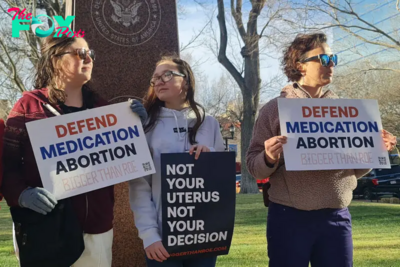Politics
US temporarily avoids government shutdown but threat remains: 4 essential reads
Congress temporarily averted a partial government shutdown that would have taken effect on March 2, 2024, by passing a very short-term funding extension.
The measure – which gives Congress more time to finalize spending packages for the current fiscal year – keeps funds flowing to government agencies until March 8 for some departments and until March 22 for the others. A short-term spending deal reached just a little over three months ago, which helped prevent the last threatened shutdown, had given Congress two deadlines: March 1 and March 8, 2024, with different departments closing down if funding wasn’t passed by each date.
Democrats and Republicans have been far apart on funding the government, as a group of hard-right lawmakers demands spending cuts and conservative policies such as new restrictions on abortion access, as part of any agreement.
If following U.S. politics feels a little like “Groundhog Day,” you’re not alone. The Conversation has been covering the increasingly frequent shutdown close calls in recent years by asking experts in politics, economics and other fields to provide context and explain the consequences of a government shutdown. The following is a roundup of some of those articles from our archive.
1. A shutdown is the wrong way to negotiate a budget
The small band of conservatives who keep staging these showdown standoffs often use fiscal discipline as a rallying cry. The government is spending too much money, they say, and it’s up to them to put a stop to it.
On the goal of reducing the high U.S. budget deficit – currently about $1.6 trillion – you won’t get an argument from Raymond Scheppach, former deputy director of the Congressional Budget Office and retired professor of public policy at the University of Virginia.
But trying to cut the deficit by holding the government hostage is the wrong way to do it, he wrote.
“First of all, shutdowns don’t get results,” Scheppach explained. “The U.S. has had 21 shutdowns over the past five decades, three of which have been major. These have all caused real harm to the U.S. economy, but they haven’t led to the spending levels Republicans wanted.”
If today’s conservatives are serious about cutting the swelling budget deficit, Scheppach suggested they take a different tack – genuine negotiation – which has generally yielded just the results they sought.
Read more: GOP shutdown threat is the wrong way to win a budget war − History shows a better strategy for reducing the deficit
2. Why political brinkmanship keeps getting worse
One big problem with negotiation is that many lawmakers in both political parties are encouraged by increasing levels of hyperpartisanship to dig in their heels and refuse to compromise. And compromise is a key part of any reasonable negotiation.
That’s the assessment of Laurel Harbridge-Yong, a Northwestern University political scientist and a specialist in partisan conflict. She doesn’t expect this to change anytime soon – even though the public wants it to.
“So you now have many Republicans who are more willing to fight quite hard against the Democrats because they don’t want to give a win to Biden,” Harbridge-Yong wrote. “However, even if individual members think they’re representing their constituents, representation at the aggregate level can be poor. What the public as a whole – which tends to be more moderate – wants is compromise and resolution.”
Read more: With government funding running out soon, expect more brinkmanship despite public dismay at political gridlock
3. Shutdowns have long-lasting costs
The group of Americans most directly affected by a shutdown are federal workers. When a shutdown happens, most are furloughed without pay, while others whose work is deemed essential – such as many in national defense – must still work, but also without getting a paycheck.
When the shutdown ends and the government is funded again, paychecks resume and workers get back pay for however long it lasted. But shutdowns can have lingering effects on worker morale and retention rates. That drives up the price tag of shutting down the government and can cause long-term damage, wrote Susannah Bruns Ali, an assistant professor of public policy and administration at Florida International University.
“Shutdowns lead to more people being more likely to leave government employment – and higher workloads and lower motivation for those who remain,” she explained. “These conditions may feed Republican political goals, but they harm the millions of Americans who depend on competent, timely assistance from the public servants on the government payroll. This ultimately leads to lower work performance and employee retention problems.”
Read more: Government shutdowns hurt federal worker morale, long after paychecks resume − especially for those considered 'nonessential'
4. Shutdowns are uniquely American
Many other countries also seem to have a great deal of political partisanship, so you might expect fights over government shutdowns to be relatively common.
If you thought that, you’d be wrong, according to Garret Martin, who studies transatlantic relations at the American University School of International Service.
“Other Western democracies experience polarization and political turmoil, too, yet do not experience this problem,” he explained. Take the British system, famous for its raucous Parliamentary sessions: “Government shutdowns just don’t happen – in fact, there has never been one and likely never will be.”
The reason for the difference comes down to four factors, Martin explained: legislative power, ease of passing a budget, political stakes and appropriation rules.
Read more: Shutdowns are a uniquely American drama − in the UK, it's just not Parliament's cup of tea
This article was updated on March 1, 2024, to reflect a new short-term funding deal.
-

 Politics7h ago
Politics7h agoWhy Trump Actually Needs Mexico
-

 Politics7h ago
Politics7h agoMan Convicted of Killing Laken Riley Sentenced to Life in Prison Without Parole
-

 Politics13h ago
Politics13h agoHow the Biden Administration Protected Abortion Pill Access—and What Trump Could Do Next
-

 Politics13h ago
Politics13h agoWhy Trump’s Tariffs Could Raise Grocery Prices
-

 Politics1d ago
Politics1d agoThe First Trans Member of Congress Expected Pushback Like Mace’s Bathroom Rule
-

 Politics1d ago
Politics1d agoNew York Prosecutors Oppose Dismissing Trump’s Hush Money Conviction
-

 Politics1d ago
Politics1d agoWhite House Christmas Tree Is a Symbol of Resilience for Hurricane-Hit North Carolina Farms
-

 Politics1d ago
Politics1d agoHakeem Jeffries Wins Reelection as House Democratic Leader Despite Party’s Losses





















